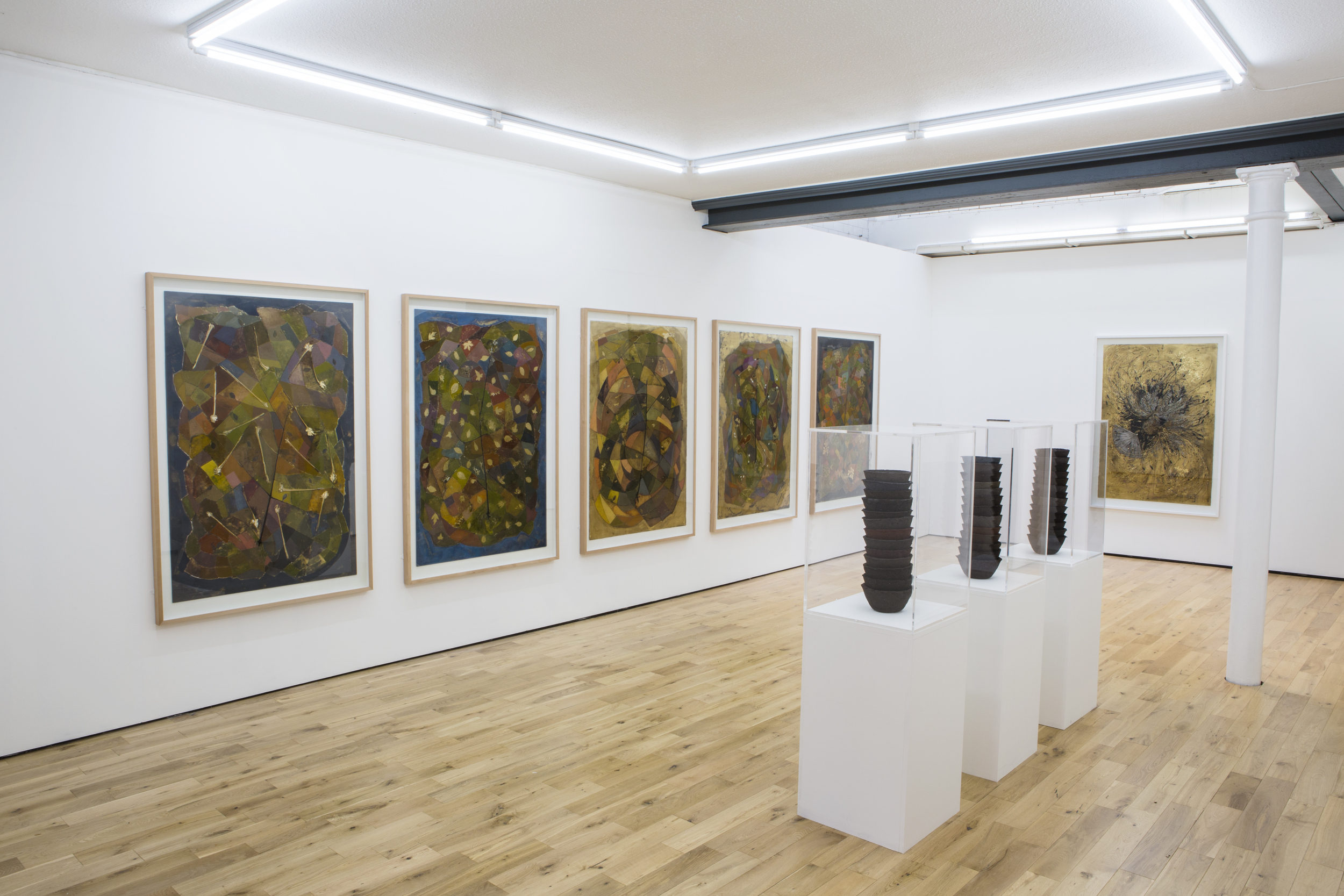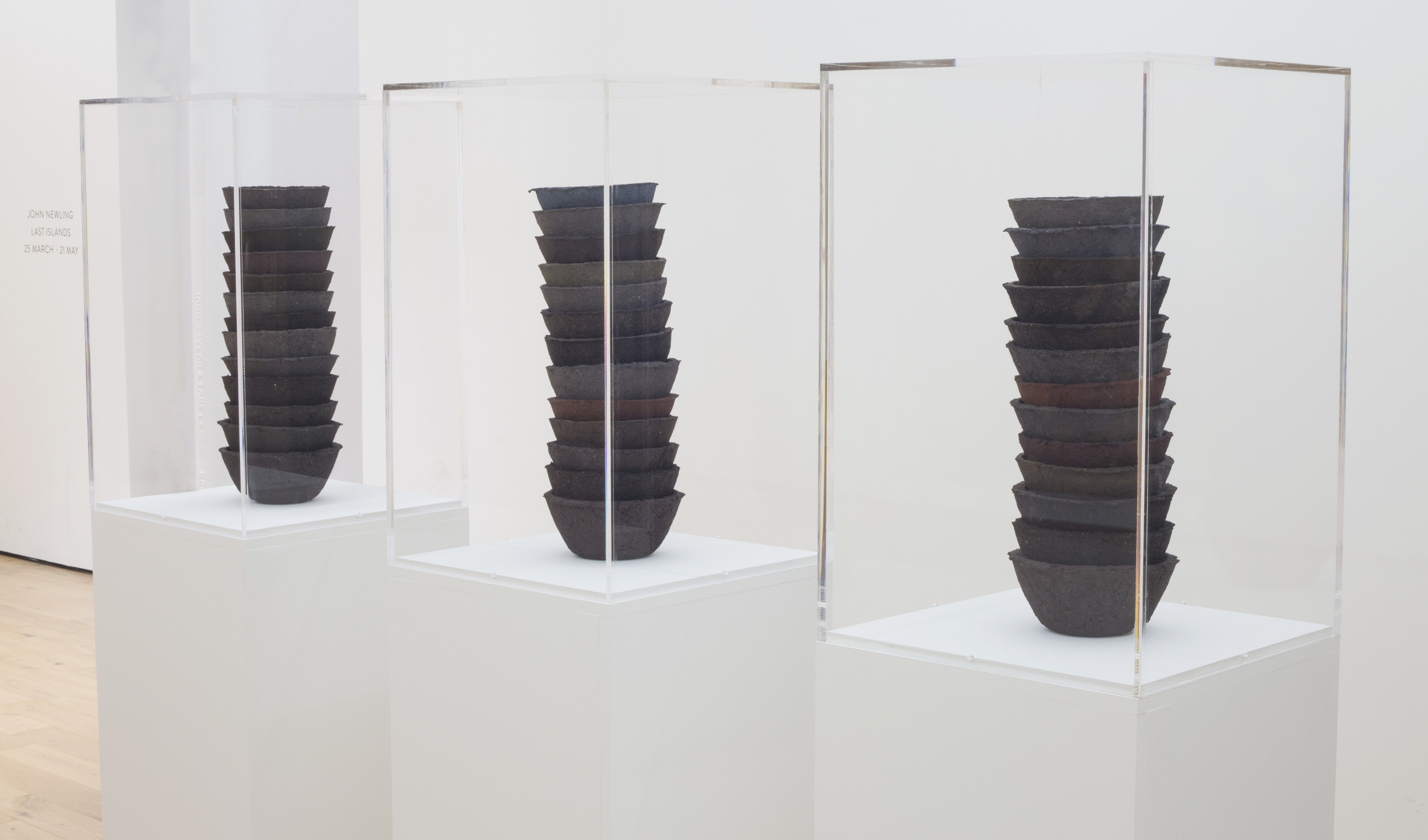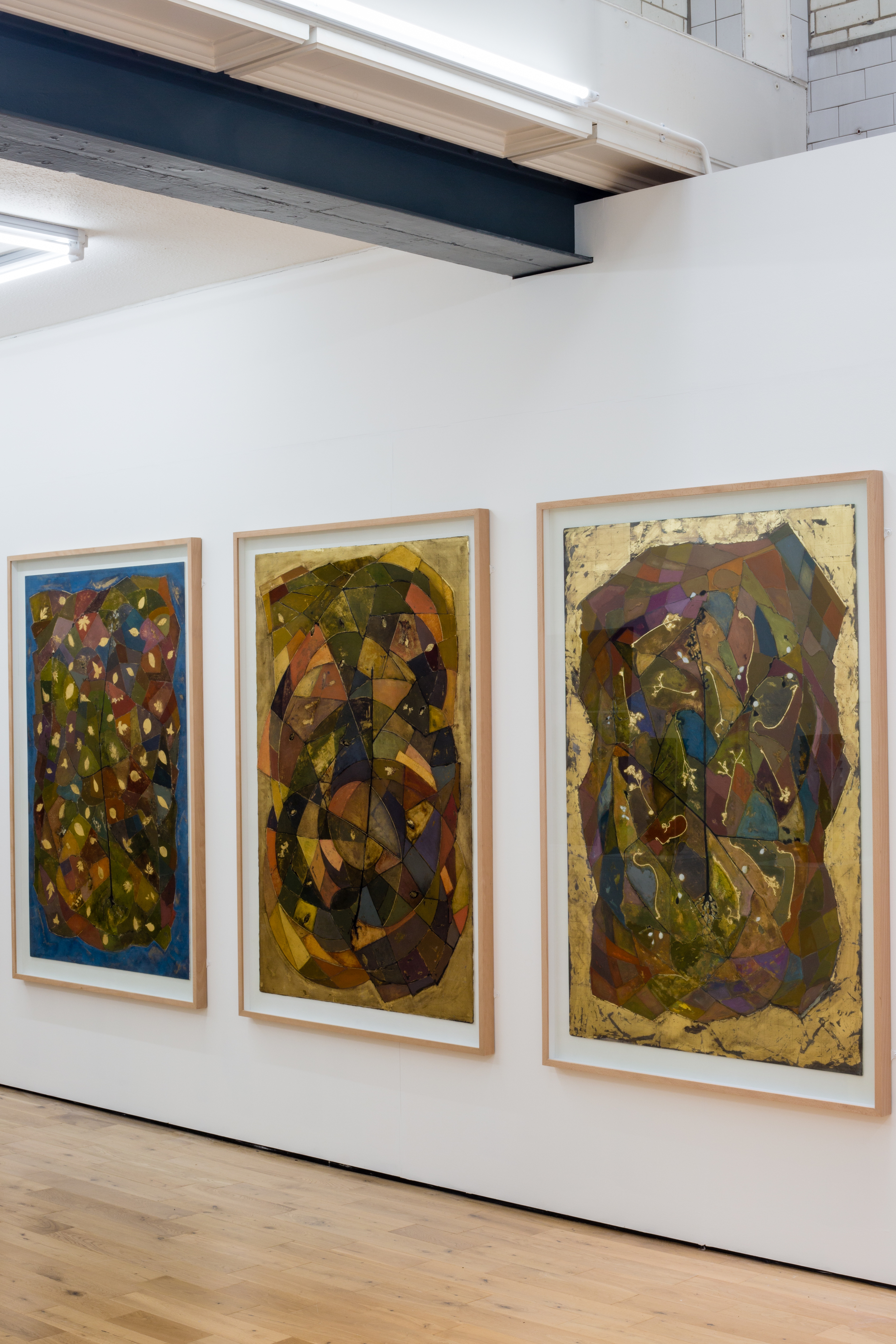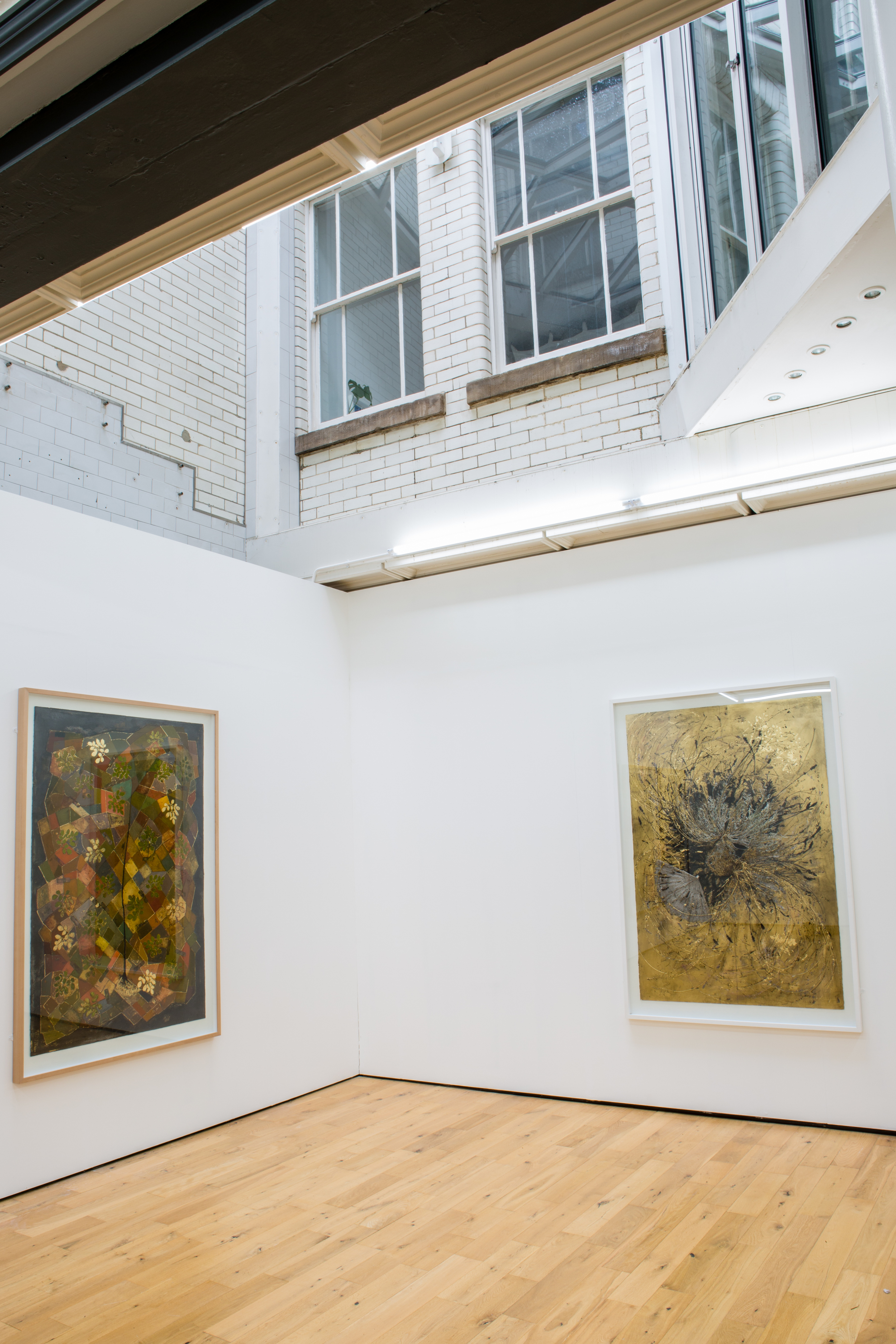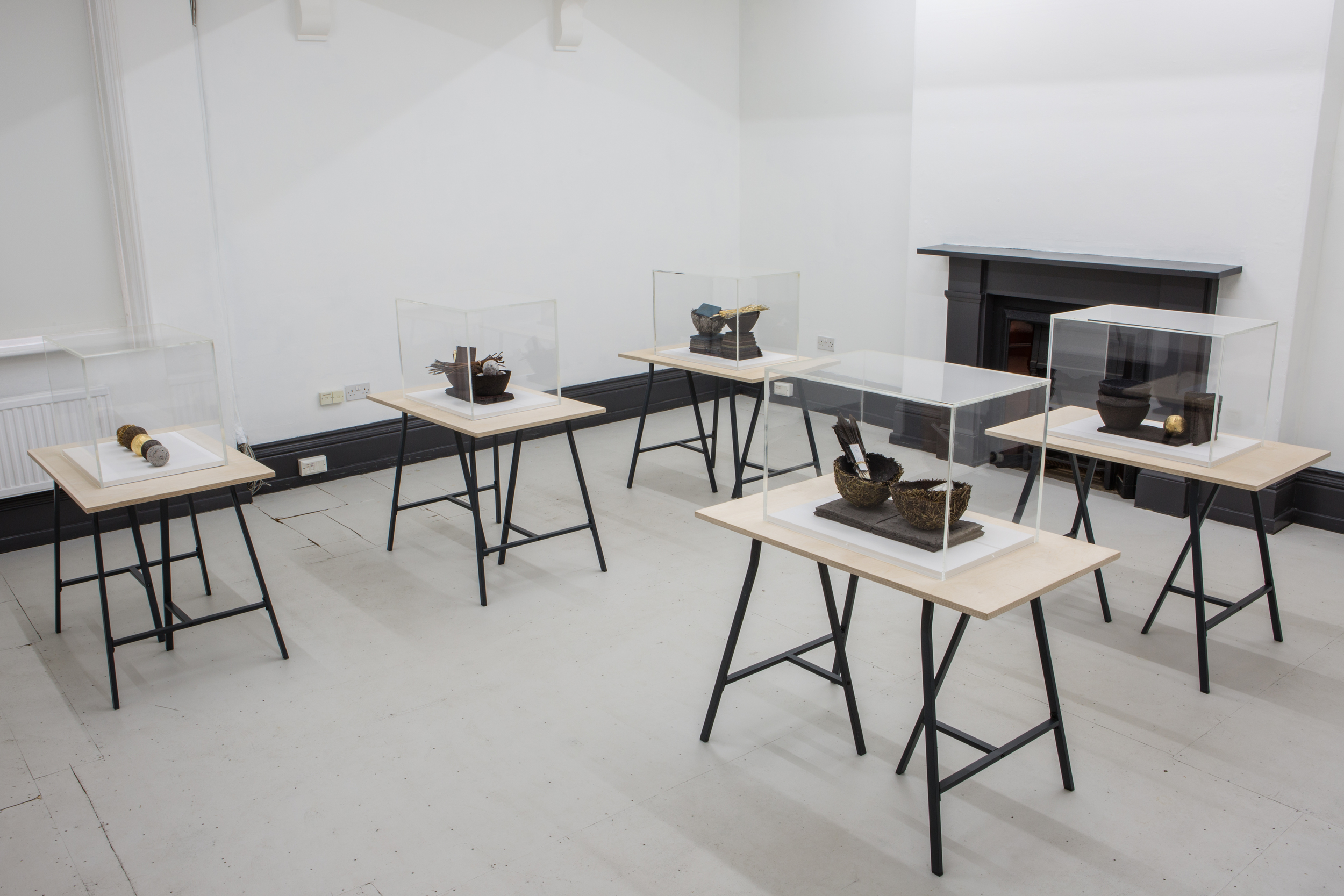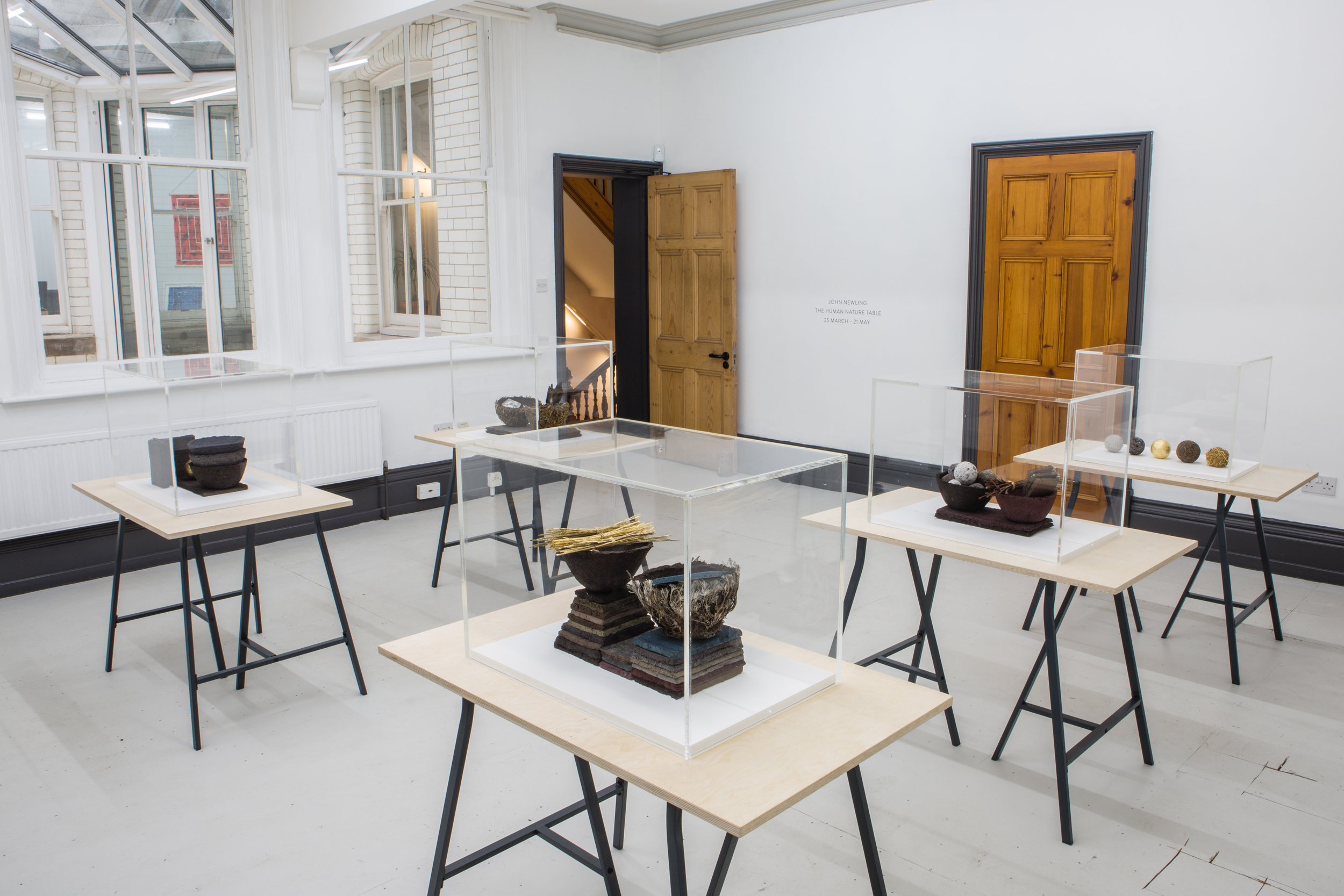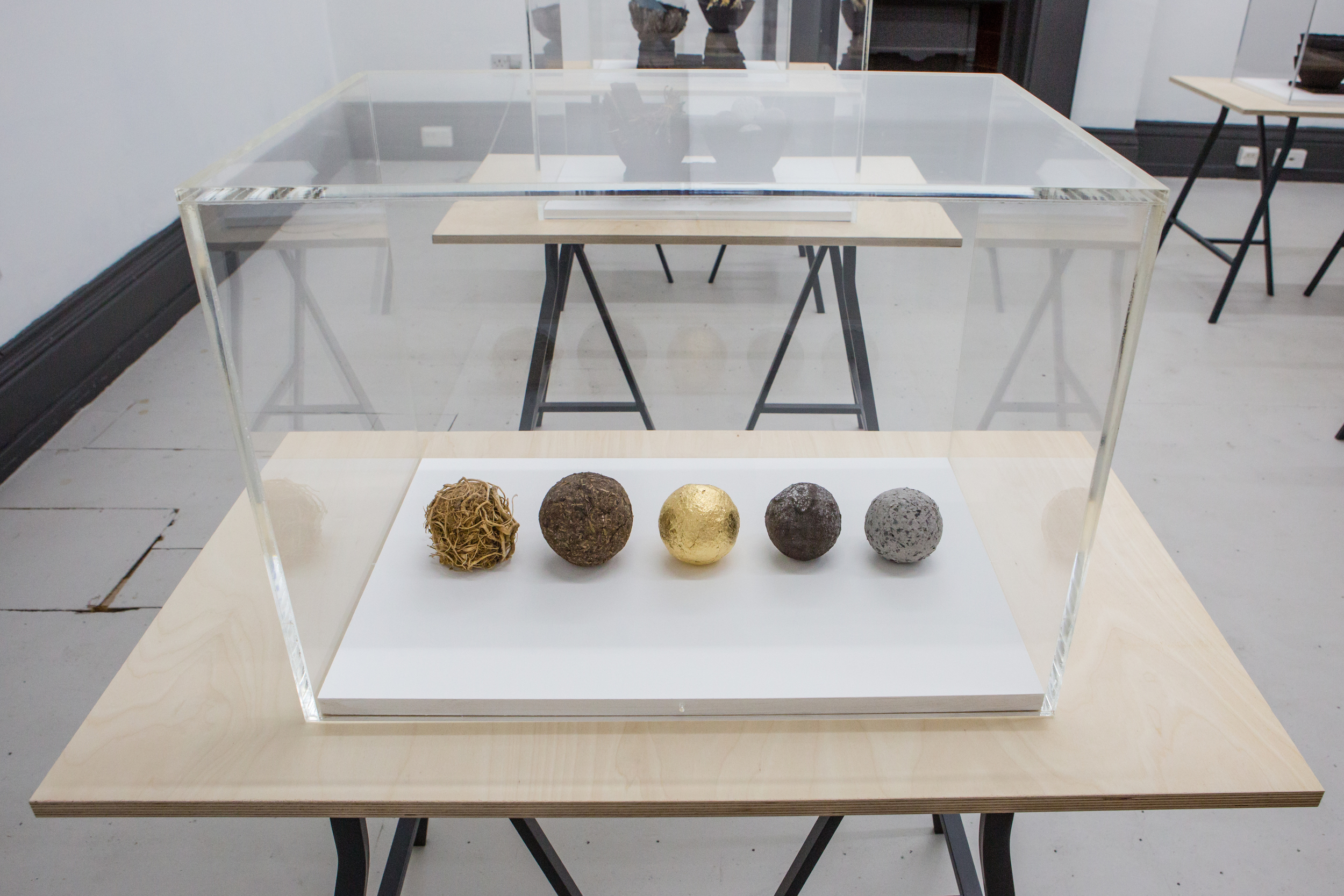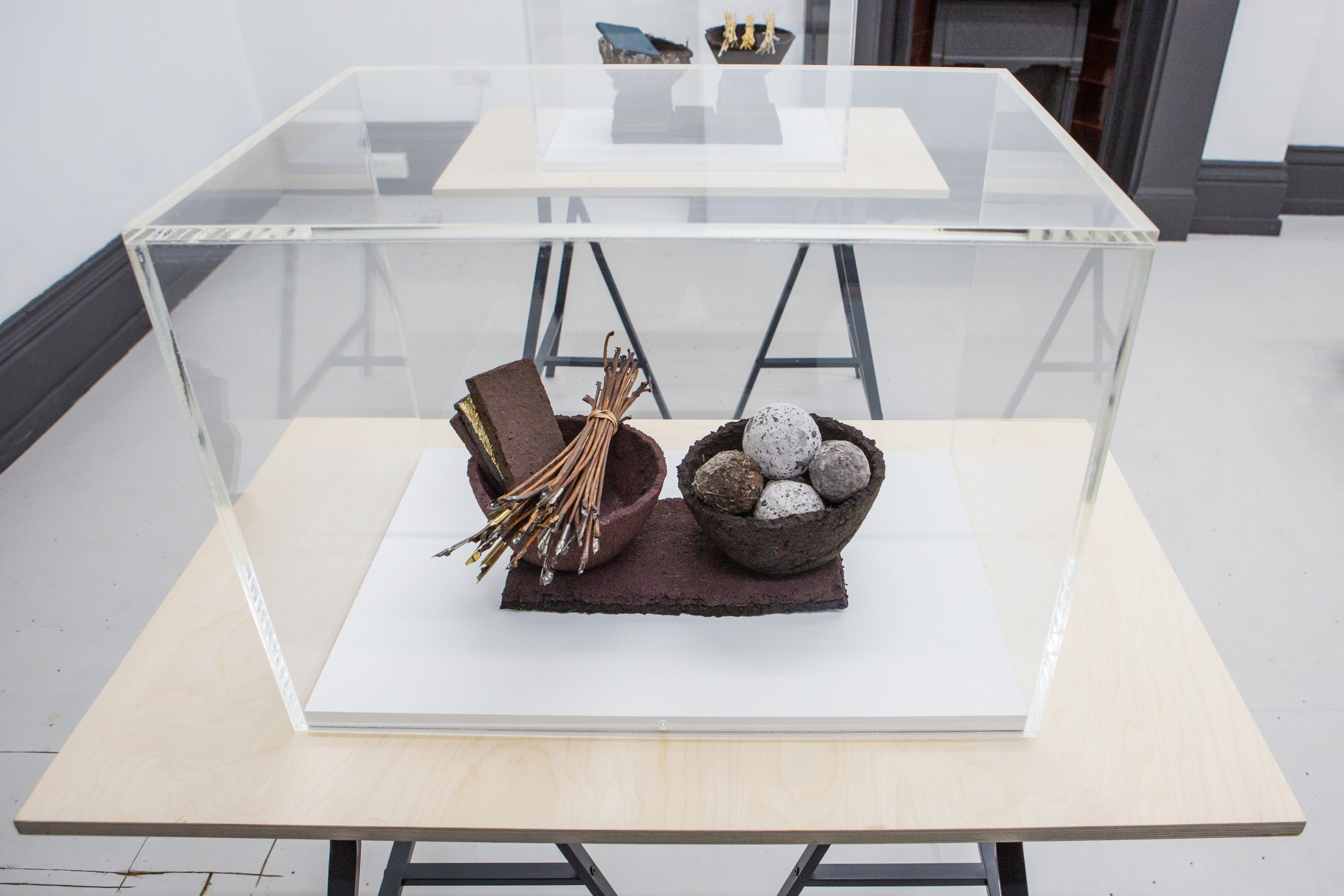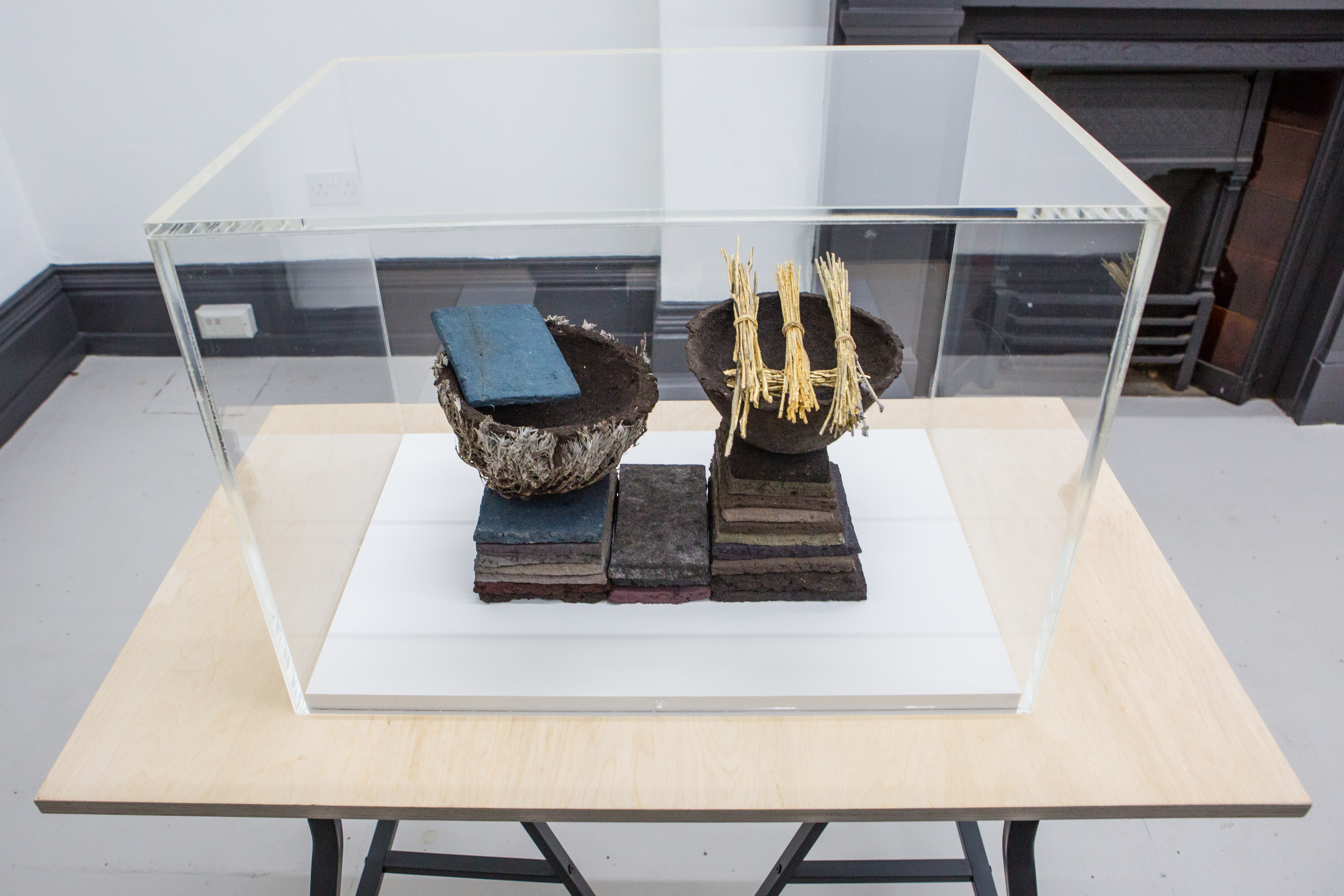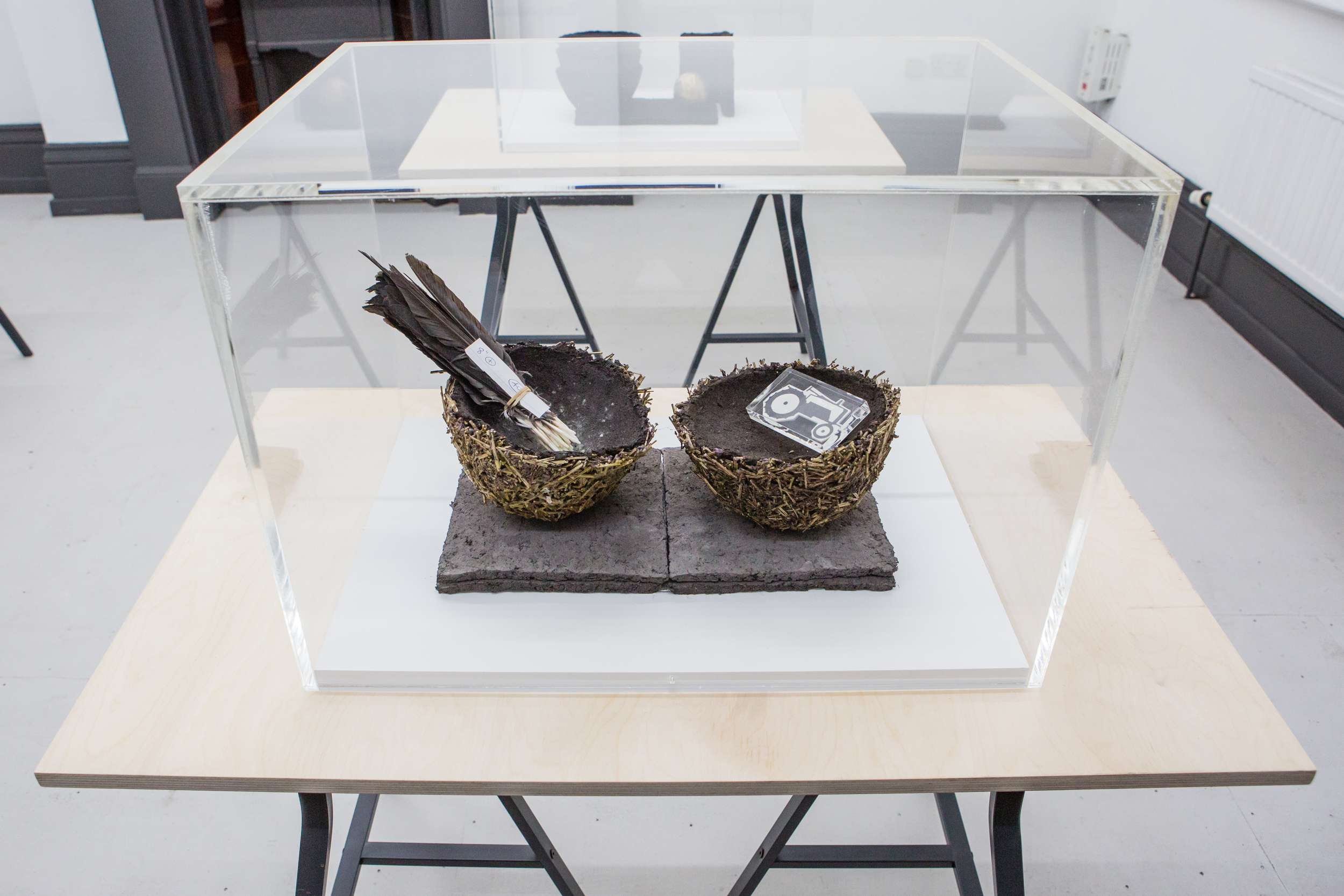Photos: Louise Haywood-Shiefer
Wayne Burrows interview with John Newling on the the ‘Last Islands’ and ‘Human Nature Table’ works. (Full version)
You've been living in Nottingham for a long time, but what was it that first brought you here?
I did an MA at Chelsea and then an MPhil at Wolverhampton as a resident artist, and I was back living with Ann where I was born in Handsworth, going through the frustration that loads of young artists go through, essentially just waiting for the phone to ring. I was really struggling to get a job. I had one day a week at Walsall, teaching film and photography, which I loved doing, and then in 1981 a job came up at Nottingham Trent University, which was obviously still the old Polytechnic then. I remember travelling from Birmingham to Nottingham and thinking “It's amazing – I like this city”. And I got the job. I was full time at NTU for three years then part time after that. And around 1981 I also made a show, Seven Trestles at the Midland Group. I was asked by Anthony Everitt, who later became the Director of the Arts Council, to build these seven trestles, for seven sculptures. But I was doing this in my flat in Handsworth at the time, so my flat was full of wood. We were sitting among these piles of timber trying to peer through them to see the television.
You mention that you were teaching film and photography, but you're probably now best known as a sculptor in a broad sense. Did you start out as a sculptor?
I think early on my work was mostly about going out and talking to people, or digging holes. The first actual sculpture I made was at North Staffs Polytechnic. I made a table football machine there, mostly because I was working with technicians who could help me build it. I made a proper working table football machine, stuck it in a pub we all frequented and people played table football there on that sculpture for a year. I was curious in those days about the relationship between the art, myself and the environment I was in, so it was really about my interest in place and space. As for teaching film and photography – well, I don't how I managed to blag my way into that job.
Was it to do with using those media to document the things you were doing?
It was documentation, but also wet printing, as I think it's called now. In those pre-digital days it was just developing and printing. It was a good move, though, because conceptually I taught the students about ideas and showed them how to process film, and they made great work and did well. I always felt slightly uncomfortable teaching film and photography because it wasn't really what I did, but the concepts I was working with were translatable. It was my first experience of teaching as well. It was a very positive but surprisingly draining time.
Of course, when I said 'sculpture' there's obviously a very traditional idea of what sculpture is, but in your early years in the late 1970s I guess there had also been an opening up of what sculpture could be, with people like Keith Arnatt or Gilbert & George... and your work seems to have been shaped by that expanded view of sculpture.
Definitely. In the early 1980s I got asked to show as one of the younger artists in an exhibition at the Walker Gallery in Liverpool, and I was showing there alongside Gilbert & George. They put us up in this hotel, the Adelphi, in Liverpool, which had the biggest bathroom I'd ever seen. The hotel room was bigger than our flat. I remember spending an evening with Gilbert & George, talking about this and that, and it definitely felt like that was the context I was working in. Keith Arnatt was another very interesting artist who was around at that time whose work I liked a lot.
I guess your own work would also have been becoming more visible during that period in the early 1980s when a kind of 'new sculpture' emerged, with people like Bill Woodrow, David Mach and Tony Cragg – would that be right?
To an extent, because I remember there had been a show called Zeitgeist, which had refreshed a kind of dare to make visual gestures after the quite tough, rigorous approach of the 1970s, when many of the shows you went to were basically the same, always very austere. So that Zeitgeist show did start to open things up. But there was also a hunger – which I had myself – to explore the transformation of materials, a sort of second Arte Povera. Arte Povera had been a movement that started in Italy, using everyday materials and processes to make works where the lines between art and life became blurred, and I felt a certain affinity with that approach which was something I think I definitely carried into my own work. On a personal level, I also had a strong feeling that it was important to ask questions: what was this art business all about? Who and what was art being made for? Where did you put it? Who was going to see it? The question of how I could engage with people around this thing that I had a hunch was important in some general or specific way but didn't want to take for granted was important to me then, and still is. Because of all that, the works I made on a Fulbright Fellowship in the United States around 1985 were significant because they were all made on the street.
Was that the tents?
Yes, there were tents, but there were also things like a series of pieces I made in Washington DC, outside the White House, buying things from the tourist stands they have there, where I was transacting plates, drawing on them, then selling them back to people at exactly the same value I'd bought them for. So I was interested in those kinds of transactions and exchanges. I also made a lot of works in hotel rooms, where I'd put together a work and just leave it there to be found. One of those pieces came up for auction recently, which I'll admit shocked me. They were meant to be left there, to be quite transitory, but someone had clearly picked one of them up, nicked it and kept it, and all these years later somehow found out who'd made it – because they were always anonymous – and put it up for auction. I got this letter asking 'is this work one of yours?' and, of course, I had to say 'yes'. So I was making a lot of work like that, with all those concerns about place and site already there.
There are certain strands that have always been there in your work, from the interest in a kind of alchemy, in the transformations of materials, to all the questions around value and exchange, faith, doubt and knowledge. These ideas seem to come up again and again in the work you've made.
Yes, they are very consistent, that's true, and they all cross over quite a lot now and get more embedded in everything I do. I think another, slightly newer strand is the work with ecologies, and how that relates to art with practical uses, which I've been getting more and more interested in. The projects about growing moringa plants were going that way, because of the possibilities for growing these plants and harvesting the leaves as a food and nutriment in those countries where they both could grow them, and where they're also really struggling to grow other kinds of crops for food. I've been looking quite closely at the construction of soils and linking my work to the Anthropocene, which is something I've really been working on since about 2005. I've got more knowledge about those things now, though. I love learning things. I recently spent a whole week in Scotland talking to world experts in the sciences of soil, from forensics through to things like pH levels, and how that affects fodder and food crops. I've now started on a new series of works which could be seen as a variety of Land Art, but are really growing laboratories. I saw an example in Scotland, which already looked like a John Newling work – a series of strips in a field on a farm, which were first set in 1922. The pH level of the soil in each strip was variable, from around 1.4 right up to 6.6 or 6.7, with one crop grown across that whole range of strips. It was a science experiment to look at the effect of pH levels on the growth of crops, but it's also simply the most beautiful and elegant piece of work in its own right. Scientists are still pulling data from that 1922 experiment, which gets reviewed every year, and when I was in Scotland I raved about it, while the scientists all looked at me like I was mad. But I could really see the connection between the Land Art I grew up with in the 1960s and 1970s and this planting that had been made in 1922 as a very practical experiment to try and better understand how things grow. I love finding that kind of correspondence between what can seem, on the surface, to be very different activities.
I think I've seen fields like that as part of the planting around an agricultural research centre near Aberystwyth…a long field running by a road, planted in strips, that at certain times of year has the look of a Land Art work of some sort. I'm not sure if it'd be exactly the same, but it sounds quite similar visually.
I'm sure it would be. The people I met in Scotland were all incredibly hard working, self effacing experts, very practical people. I've been working up there on and off for two years now and one of my jobs, I think, is to try and understand, in as much detail as I can, what they're doing. My knowledge is still very limited but as I understand more it gets easier, and the different languages get shared. But I do think it's important to properly acknowledge what those scientists are doing, at a time when climate change makes their research into the way soils change under different environmental conditions especially important. It's fantastic work, but it's not known about as much as it should be. Perhaps just getting that information about their knowledge and skills out there, to audiences beyond their own specialist scientific fields, is something my work is interested in helping with in whatever way it can.
Your approach to art does often have this scientific aspect, so when I think about something like 'The Lemon Tree & Me' it seems mainly observational, taking the form of a diary. It echoes a kind of eighteenth century amateur naturalist's approach, the kind of thing an educated parson or schoolteacher would have done before natural science became a series of more specialist pursuits.
I don't think it's that conscious, but there probably is an element of that. The Lemon Tree & Me was a project where for 688 days I tried to grow a lemon tree in soil constructed from a newspaper that I'd made for another project. It was a tremendously interesting thing to do – and recently, in New York, the text of The Lemon Tree & Me was read out loud, which was wonderful. What The Lemon Tree & Me did, or what it was attempting to do, at least, was try and work out a relationship between myself, as a representative of the human species, and nature, something that's obviously very fraught. We need to think a lot more deeply about what that relationship is, and what it might become. As human beings, I think we need to be needed, and one of the things we've forgotten – or perhaps one of the things that through the ages has upset us – is that we know our environment doesn't need us, but we also know that we need it. So there's a kind of lover's quarrel going on, which at times is echoed in The Lemon Tree & Me. But it's also about a complete immersion in the wonder of this system that I'm observing, the system that can produce this tree. The Lemon Tree & Me was basically just me observing and recording that process, but it also had aspects which were like a love song – it was really about me learning to trust something outside my control. As human beings, I think we find it difficult to trust things. Again, I think that's a very 21st century condition, so what The Lemon Tree & Me project did was teach me that we do have to trust things, that while in our past we might have evolved to respond to 'fight or flight' instincts, we might now need to evolve differently in order to survive. That project led me to think about how the human species seems to want to control its environment completely, and about how the way nature exists at present might not be the environment we actually want as a species, even though we depend on it. We might be inventing, digitally or by whatever other method, a completely new set of environments for ourselves. Which is a thought that appals me, in many ways, but those were the thoughts taking shape in my head during that project. At a basic level, I'm interested in why we need to be needed and why we haven't accepted that small acts of kindness can fulfil that need. I find myself asking why we can't just be kind, because it would be a much better world if we were, and I don't really understand how that isn't yet obvious to us. So part of my work is about working through that and trying to understand it. I'm currently writing a series of 'Dear Nature' letters which are apologies, but also questions – and that's sort of how my process works. I usually have some small text on the go that's trying to eke out certain things from my thinking.
That sounds almost romantic, in the art historical sense – the idea that nature had its own existence, separate from human civilisation, that emerged around the industrial revolution. This might seem like a version of that, but emerging in a post-industrial, electronic and digital era?
I think it's a necessary way of thinking, looking at where we are now. I know enough about the current state of our environment to understand that we do need to change and evolve as a species if we're going to survive. So I don't see it as romantic, I see it as very necessary, a matter of urgency. The political things that are going on are political things, but none of that will really matter if we manage to reduce our energy outputs, say, but still haven't understood that we need to be kind. Nothing really changes if we don't change that. There's a fascinating cartography that can be made of the world we live in and I do tend to find myself thinking a lot about those kinds of things.
I was going to ask later about the current Syson Gallery show, 'Last Islands', but since you mention cartography there seems to be a connection there, in that these new works have the look of maps, like landscapes or field systems viewed from above. I wondered if you could talk about these works in that context?
Well, they all start with a kind of mapping process, so maybe there'll be a tree I've grown that is pressed to a surface, then that surface is gilded and black paint put over the top of that. Then the plant is removed and that's the starting point. It becomes a kind of mapping of this relationship between myself and the imprint of something natural, day in, day out, for many, many hours, while I try to work out what this relationship might be. It's a bit like The Lemon Tree & Me in that the work is about the relationship between it and me, something outside myself and myself, as I struggle to understand what's needed to take it where it needs to go. Mapping is also probably the most consistent thing I've done since childhood. I've always gone on walks, and on those walks – even walking here today – just connected the things I've seen with other things. It's a Situationist thing, in a way, because their idea of the dérive, walking without any particular purpose or destination in mind, means that somewhere in the back of my head is always that phrase: “the map is not the territory”. What I'm trying to do in these Last Islands works is to make the map into the territory. The works embody a day-to-day mapping process, and there are certain elements in Last Islands that feel very truthful to me, where the works have said 'this is what is needed' and I've responded to that. Making these pieces is always, on some level, about that reciprocal relationship and it's only when that process of reciprocation is exhausted that the work is finished.
The 'Last Islands' works seem quite different to other works of yours, partly because they appear to reference, whether by accident or design, a tradition of landscape painting – I thought of Ceri Richards, Peter Lanyon, that quite particular mid-century thread in British landscape painting.
I'd have to say I don't see them in that way at all myself, partly because I don't really know that history you're describing very well, but I do see these works as landscapes. They are landscapes on many levels, so conceptually they have that idea of landscape encoded into them, but in the process of their physical making they also have quite literal layers and elements drawn from the landscape in them too. They exist to look at, to think about and enjoy, and they represent what's in my head in the sense that this is how I see, so they do have a directness about them. But when I work on the Last Islands pieces, it's usually while also working on other things. When they're in progress, they become a place I can go to, where I can try out certain things as I'm learning and feel my way. It's a process, then, but not always a very clean or straightforward one.
One thing that seems to relate to your comments earlier about our place in landscape seems applicable here, in that the 'Last Islands' refuse to distinguish figure and ground in a suggestive way. We can try to read them as if the plant forms are foregrounded against the map patterns, but the lines are very blurred as to where these foregrounds and backgrounds begin and end.
Yes, I think that blurring of figure and ground is part of what those works are exploring, and another aspect is that some of these Last Islands works, the big ones, are also about where I live. Living in the house we do, with a garden, which is also my studio – along with various other rooms that are used for studio purposes – these works are a celebration of that landscape I inhabit every day, mapping the spaces I work in. From that garden in Nottingham, I can look out over other gardens, and I'm constantly working in that garden, or in the cellar spaces next to the garden, where I can make this Last Islands kind of work, or work in other spaces which are set up to make more sculptural kinds of work – so partly, it's very much about mapping that physical and mental space through different seasons. It's really about what I'm looking at on a daily basis as I work.
It's striking that the colour in these pieces has a natural feel, so you're not using heightened or artificial colours: it's predominantly earth tones, metals, soil, stone and clay kinds of colouring.
The colours are crucial to me, and they're layered and layered and layered, and then got rid of, then layered again, until it feels right. I find these things very difficult to do, so it's a real boost in those few moments when you've got a colour down on the surface and it's right, and you know it's right. You know you can leave it and move on to another section. It takes a long time to find the right colour, but once a colour is right, I don't change it, I leave it alone.
Which I guess brings us back to the constructed soils. And those are part of this new Syson Gallery exhibition in the 'Human Nature Table', and in the stacked forms of 'Study I, II and III'…
The vessels in those pieces are cut from my garden. They're bowls and I'm very interested in the ways soil can become a tool. The soil is bound into a simple mould that shapes them and stacking those bowls is an active statement. When I started making them, I got excited by the process of stacking them, especially with the range of colours you could get. You'll notice with these works that although they are sculptural, they work almost like a drawing or a painting. The bowls are laid out – there's 33 of them, I think – and then I stack them, working with what feels like the right colour strata for each group. Human Nature Table is an ongoing project, something that's been developed from this. It's about looking at the architecture of a relationship between ourselves and the natural world, and it gradually evolves. But by bringing certain acquired things into play alongside the natural materials, things like the feathers, rubber stamps, twigs and nibbed pens, I can also bring in the idea of the human, and work towards a kind of translation of the language of the natural world. I'm essentially a boy from inner city Birmingham, so I didn't grow anything until quite late in my life. The first thing I remember trying to grow for an art project was in 1991, in a piece made for the opening of the Museum of Modern Art in Dublin, where I tried to grow Walking Stick cabbages, something I also did for Ecologies of Value, the Nottingham Contemporary show in 2012. Ever since that point, I've continued to be enchanted with the alchemy that occurs when you put stuff into soil and watch it grow. I've learned a lot more about what's going on below the soil, how that process works, in the years since, but I'm still constantly amazed by what the natural world is and what it does. Especially now, as it's turning to Spring – this time of year when the trees are going slightly green while the canopy of them still has its structure exposed – to me it's like those trees are spinning, in my head they're spinning like gyres. And they are immensely powerful things. I think we've yet to properly grasp the significance of this earth we live on. We've forgotten where we are, a little bit.
You mentioned the idea of an architecture of nature, but when I was looking at those 'Human Nature Table' pieces the thing that came to mind first was archaeology. They have the look and feel of archaeological specimens, which connects to that idea of the Anthropocene you noted earlier.
Completely. That's accurate. When I was building those bowl pieces, maybe halfway through making them, I went to Scotland for the week with the soil scientists I mentioned earlier. Part of what I was looking at there were holes in the ground. I was learning how to dig a square hole for scientific soil sampling, sixty centimetres by sixty centimetres by sixty centimetres, a cube. It's done with amazing skill and I was amazed to meet scientists whose job was, basically, to dig holes. It was lovely to see this. I've always been on walks, and while walking found myself drawn to things like traffic works, holes in the ground. I love the archaeology you can see in those spaces, the layers of soil and other materials, and I suspect everyone is drawn to them simply because it's a dark space that we know nothing about, or feel we don't know very much about. In those works, then, it's always about trying to draw these different ideas and experiences together, it's a learning thing for me in the studio. It might be highly aestheticised, with aesthetic decisions being made, but it's also strongly rooted in that learning process. In some of the Human Nature Table works there are nests made of lavender, and the soil used in those particular pieces is the same soil in which I grew that lavender. So there are lots of connections in these works that I wouldn't really expect anyone else to notice, but it's important to me that they are there.
I wanted to go back to your comment about the Situationists, particularly the way your approach might link to that slogan circulated during the 1968 revolts, “beneath the pavements, the beach”. I think it came from someone noticing that cobblestones were laid over sand, but it also has a poetic and political dimension which seems to link to what you're saying about road-works and holes in the ground – a sort of “beneath the pavements, the soil” version of that same idea?
Yes, absolutely, it is all about what's right under our feet. People often say: “isn't it amazing that a blade of grass will cut through tarmac?” Which it can. But the question of where it gets its strength from is fascinating, and even though I know a little bit more about that now than I once did, there is still a sense for me in which the more I learn, the more questions I have. It's always a case of 'the more I know, the less I know'. Always. What I hope I'm able to do is to simply see these things, and appreciate them, and from that appreciation allow the work to evolve. As for the Situationists, they've always interested me even though I don't really know that much about them. But their idea of the dérive, walking through city spaces without a purpose or destination, was very much in tune with what I did anyway, and have done all my life. I've always enjoyed it. People often talk about the journey they're on but I find that idea of being on a journey very difficult. When you're on a journey there's an implication, an assumption that you know where you're going, that there's a destination of some kind. But I haven't got a clue where I'm going. So I find that dérive approach of having no particular destination or purpose in mind offers a very useful perspective.
Does this also relate to certain practicalities to do with living in Nottingham, in that it's a city, but a city scaled so it's mostly possible to walk almost everywhere, something you can't really attempt in places like London or Birmingham?
Well, I am a creature of habit. I'll get up in the morning every day and walk over to Tesco to buy a bottle of milk. But it's more than just a habit. It's that walk becoming where my day starts, where my head begins to sort itself out or starts to review the problems I'd set aside the night before. I am always drawn to walking in cities. Even in Los Angeles, when I was there, I walked, because I can't drive. We had a car in our family in my childhood but it was my father's car, and he died when I was quite young, so after that we didn't have a car. But the reason I never learned to drive was firstly that I don't think I'd be a very good driver and would be too scared of hurting someone in an accident to try it and, secondly, because I do genuinely really like public transport. I'm in favour of it. I've seen it in Nottingham, that when the public transport infrastructure is right, it transforms the city and it transforms your experience of the city – and Nottingham has an exceptional public transport infrastructure compared to many other places I've been. The cultural infrastructure here is exceptional too. When I go away and come back here, I come back mainly because this is where I live, but I live here because I genuinely like the city. When I've been away somewhere, and I walk out of the railway station, it's into streets that are usually packed with young people milling around, and returning to the place just feels exciting.
I remember when I first came here, there were things like the Now! Festivals, and I think it was for one of those that you installed the floodlights and towers in Market Square…
Yes, that was a piece called Saturday Night & Sunday Morning.
I know there have been other pieces like that made in response to particular city spaces.
Yes, and in a few years, or maybe a decade's time, I'd like to try and develop some of the short texts I work on for – well, only a few minutes each day, I suppose – but to try and get a few of those texts, which say things like “We needed to be needed but forgot where we lived” or “Be kind” and see if they might be installed permanently somewhere in the city.
Is the one you made for a street in Sherwood still up? “Know You are Loved”.
Yes, that's still there and the people who live on the street have adopted it, which is wonderful. When you see something like that in your environment I hope it wobbles the standard etiquette a bit, grounds you in where you are, so I'm very conscious of that positive effect and it's something I'd like to do again. Saturday Night & Sunday Morning, a temporary installation which was commissioned in 1991, started with the relatively simple idea of putting three times the amount of light into the Market Square as Nottingham Forest had in their football ground, making a warm space in the middle of winter. It had a big effect, and some of that effect was political, as it led to the City Council talking about relighting the Market Square because it was a bit dark at that time, and there had been a few incidents and reports of people being too scared to walk through it at night. I watched how that piece worked at night from a nearby building, and saw how people used that warm space in the middle of November, seeing how they'd come out and relax there.
The text pieces seem very different to the soil works but seem to relate to a similar set of concerns. Should we see these works, or those exploring faith and doubt, as exploring text as a kind of soil from which the cultures we live in rather than the plants we depend on grow?
Well, all the work I've made comes out of the same head so those connections are there. And with language, I do love poetry. I would say I'm a big reader, but I'm not, really. I have read things like Yeats and Eliot, though, and I think I understand more about what they were writing as I do more work myself. Also, because I'm dyslexic, I've always had to try hard to write and get myself into the habit of writing. I enjoy the challenge of writing, paring back words, allowing ambiguities to appear and exploring their effect on the space or place where the text is. So the process of mapping in these texts isn't exactly the same as digging into the earth to find out things about the soil, but it involves a similar process.
The texts might be seen almost as nurturing additions to the soil that we inhabit culturally, a language designed to grow things like a stronger sense of community, perhaps?
I'd love to walk out of the railway station one day and see a sign there that just says something like: “Be Kind”. I think it would have a good effect on anyone who walked out of that station. In some ways, this is the thing I think about all the time, but I don't know. I'm completely enamoured by all the questions we can ask about our environment and our relationship to it, but it's also something we haven't properly begun to address yet as a species. That process is just starting. I've met people who are really working on this, discovering new things about plants all time, things we still had no idea about. But against that positive feeling about future possibilities is the constant barrage of news, and my exposure to that is partly my own fault because I often choose to work with the radio on. So when I think of the one thing against the other, about that new thinking set against the media barrage, about the necessary questioning against the stupidity, it's somewhere in that collision and friction that the work gets made. It's from that conflict that my thinking about the work comes. Sometimes, if I get too cross, I'll just go for a walk, where I can begin to work out how that stupidity happens while also thinking about those other possibilities. In that way, I suppose I do put all of that material, good and bad, back into the soil to see what I can grow from it, to see if anything better can be made with it, so in that sense your analogy is probably accurate.
Is there anything in particular you'd want to add to what we've already discussed, or perhaps something you'd particularly want to emphasise?
I think one thing I'd emphasise would be the consistency of approach, so if I go to another country to make a work, it's made using exactly the same approach as something made here. One thing that's very important to me is knowing that the language I use in my work is shared, so that wherever I make work – with the sole exception of the English language of the texts, which can be translated – it will be understood. I hope this new Syson Gallery gallery space that Last Islands has inaugurated does well too. It really deserves to.
It's interesting that your show here feels like a new direction of sorts, even if it's not, in terms of your work as a whole.
Well, the Last Islands pieces have evolved from the same concerns and body of work as everything else, and they are linked very closely to my growing projects, especially those around growing moringa plants, some of which appear in these works. The larger pieces here all feature moringas, apart from one, set to one side of the others, which features a lavender. But the moringas were a project I first showed at Lancaster University, then some of the work went on to Nottingham Contemporary, and now there's a whole new body of work that's arisen from that project made since 2012 that hasn't been seen yet. One day, I'll bring the whole lot together and the connections between those moringa works and these Last Islands pieces will become much more explicit. The main reason I chose to show Last Islands at Syson Gallery was that I wanted to show something new.
